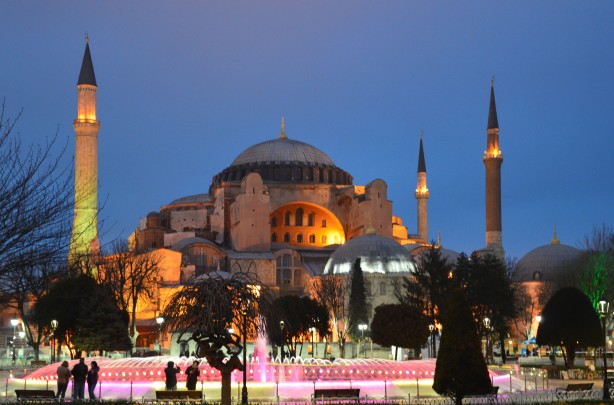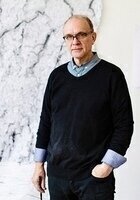All AP Art History Resources
Example Questions
Example Question #41 : Architecture
Depictions of Christ as the Pantocrator are most common in which period of art?
Byzantine
Gothic
Romanesque
Renaissance
Byzantine
Throughout the history of Christian art, Jesus Christ has been depicted in a variety of roles. During the Byzantine era, depictions of Christ as the Pantocrator, or "ruler of the world," were common. Images of the Pantocrator appear at the top or center of Byzantine hierarchical compositions, and are often flanked by angels.
Example Question #1 : Early Christian, Byzantine, And Early Medieval Architecture
The deep-carved stone decorating the pillars and other structural surfaces of the Hagia Sophia, combined with the close spacing of the windows at the base of the dome, suggest what about the building?
Emperor Justinian instructed his architects to copy the Classical Greek style.
That the cathedral's decoration was meant to contrast sharply with Islamic architecture of the same time.
That the stone structures actually are not supporting the building or its dome, but it is instead floating in an otherworldly manner.
That the builders and craftsmen employed in its construction were very skilled at working with stone and glass.
That the stone structures actually are not supporting the building or its dome, but it is instead floating in an otherworldly manner.
The deep carving on the Hagia Sophia's pillars and in other decoration makes them appear hollow and too delicate to support the cathedral's weight. The close-set windows lining its golden dome's base create the illusion that the dome is floating. Together they suggest that the whole building is supported by some divine power rather than by its own structure.
Example Question #42 : Architecture

The building was originally a __________.
temple
civic building
mosque
church
church
The Hagia Sophia was originally built as an early Greek Orthodox church. It is difficult to consider the architecture as of a particular time period or style as it has been changed and influenced so many times. There are, however clear remnants of Greek Classical style as well as the early hints of what will become the Romanesque church style.
Image adapted from http://www.publicdomainpictures.net/hledej.php?hleda=hagia+sophia+5.
Example Question #2 : Early Christian, Byzantine, And Early Medieval Architecture

This building does NOT have a(n) __________.
apse
nave
atrium
narthex
atrium
The church is a combination of central and Basilica plan. It has all of the standard additions of those styles, including the nave and apse, as almost every church of this type does. The narthex is identified as the porch-like addition opposite the apse. This church does not have an atrium, however, which would look like a long open plan that sits before the church door.
Image adapted from http://www.publicdomainpictures.net/hledej.php?hleda=hagia+sophia+5.
Example Question #43 : Ancient Through Medieval Architecture

The plan of this building is __________.
Romanesque
central and Basilica
longitudinal
Classic
central and Basilica
The Hagia Sophia has all the standard additions of the Basilica-plan church, including the apse opposite the door, a nave in the center, and aisles on each side. It lacks the cross-like arms of later Basilica churches. It also has a domed top and a square-ish base, which are both central-plan additions. It is unique in this way among its contemporaries.
Image adapted from http://www.publicdomainpictures.net/hledej.php?hleda=hagia+sophia+5.
Example Question #44 : Ancient Through Medieval Architecture

Construction of the building in its current form began in __________.
the sixth century BCE
the ninth century BCE
the eighth century BCE
the fourth century BCE
the sixth century BCE
The current layout of the Hagia Sophia was begun by Justinian II in 532. It was ordered after his predecessors tried and failed to build a monumental building in that area. As Justinian was largely regarded as the first Byzantine emperor, the Hagia Sophia became a seminal work for Byzantine and later Eastern Orthodoxy churches.
Image adapted from http://www.publicdomainpictures.net/hledej.php?hleda=hagia+sophia+5.
Example Question #2 : Early Christian, Byzantine, And Early Medieval Architecture

The architect of the building was __________.
Procopius
Isidore of Miletus
Eusebius of Nicomedia
Justinian II
Isidore of Miletus
Isidore of Miletus, along with his companion the mathematician Anthemius of Tralles, was commissioned by Justinian I to create the Hagia Sophia. Anthemius died shortly before construction could begin, so Isidore continued alone. He was considered the father of the current structure, minus the Islamic artistic additions.
Image adapted from http://www.publicdomainpictures.net/hledej.php?hleda=hagia+sophia+5.
Example Question #241 : 3 D Art

The tall, thin towers are called __________.
minarets
cornices
muezzins
muqarnas
minarets
The towers are called minarets. They are an Islamic addition to the church, added when it became a mosque in the fifteenth century after the Turks sacked Constantinople. These towers are not universal, but are common in Islamic mosque architecture.
Image adapted from http://www.publicdomainpictures.net/hledej.php?hleda=hagia+sophia+5.
Example Question #51 : Ancient Through Medieval Architecture

The interior of the building is likely decorated with __________.
mosaics depicting biblical figures
precious metals
encaustic designs
rich oil paintings of Christian martyrs
mosaics depicting biblical figures
The Hagia Sophia was built just after the birth of the Roman Christian tradition, and came well before the advent of Renaissance oil paintings in churches. It was also built in the Middle East, and was influenced by the artistic traditions of the area. It therefore likely has mosaics on the inside, which are the cornerstone of Byzantine church art.
Image adapted from http://www.publicdomainpictures.net/hledej.php?hleda=hagia+sophia+5.
Example Question #52 : Ancient Through Medieval Architecture

Why would the Islamic Turks cover the mosaics on the interior of this structure with plaster?
Islamic Turkish places of worship traditionally featured plain, undecorated interiors.
The building was sacked, and the mosaics were taken apart and shipped to interested foreign parties.
The Turks did not appreciate mosaic art.
The Islamic tradition forbids the artistic depiction of figures.
The Islamic tradition forbids the artistic depiction of figures.
Islamic tradition bans the depiction of figures as inspiring idolatry; works depicting figures would be considered sacrilegious. When the church became a mosque, the mosaics were plastered over so that there were no faces in the new mosque, and there would only be Arabic script as decoration.
Image adapted from http://www.publicdomainpictures.net/hledej.php?hleda=hagia+sophia+5.
All AP Art History Resources




